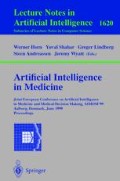Abstract
ECG interpretation is used to monitor the behavior of the electrical conduction system of the heart in order to diagnose rhythm and conduction disorders. In this paper, we propose a model-based framework relying on a model of the cardiac electrical activity. Due to efficiency constraints, the on-line analysis of the ECG signals is performed by a chronicle recognition system which identifies pathological situations by matching a symbolic description of the signals with temporal patterns stored in a chronicle base. The model can simulate arrhythmias and the related sequences of time-stamped events are collected and then used by an inductive learning program to constitute a satisfying chronicle base. This work is in progress but first results show that the system is able to produce satisfying discriminating chronicles.
Access this chapter
Tax calculation will be finalised at checkout
Purchases are for personal use only
Preview
Unable to display preview. Download preview PDF.
References
A. Bardou, P. Auger, P. Birkui, and J.L. Chasse. Modeling of cardiac electrophysiological mechanisms: From action potential genesis to its propagation in myocardium. Critical Reviews in Biomedical Engineering, 24:141–221, 1996.
M. Blondeau and M. Hiltgen. lectrocardiographie Clinique. Ed. Masson, 1980.
D. Berleant and B. J. Kuipers. Combined qualitative and numerical simulation with q3. In B. Faltings and P. Struss, editors, Recent advances in qualitative physics, pages 3–16. MIT Press, 1992.
R. Le Blanc. Quantitative analysis of cardiac arrhythmias. CRC: Critical Review in Biomedical Engineering, 14(1):1–43, 1986.
I. Bratko, I. Mozetic, and N. Lavrac. Kardio: A Study in Deep and Qualitative Knowledge for Expert Systems. MIT Press, 1989.
M. Ghallab. On chronicles: representation, on-line recognition and learning. In Fifth international conference on knowledge representation and reasoning (KR'96), pages 597–606, Cambridge (USA), 1996.
M. Guertin. Abductive inference of events: Diagnosing cardiac arrhythmias. In Proceedings of the Florida Artificial Intelligence Research Symposium, May 1996.
J. Hunter and I. Kirby. Ticker: A qualitative model of the electrical system of the heart. In Research and Development in Expert System XII (Proc. of Expert Systems'95), pages 293–307. Information Press, 1995.
M. Kundu, M. Nasipuri, and D.K. Basu. A knowledge based approach to ecg interpretation using fuzzy logic. IEEE Trans. Sytems Man and Cybernetics, 28(2):237–243, 1998.
W. J. Long. Temporal reasoning for diagnosis in a causal probabilistic knowledge base. Artificial Intelligence in Medicine, 8:193–215, 1996.
W. Van Laer, L. De Raedt, and S. Dzeroski. On multi-class problems and discretization in inductive logic programming. In Zbigniew W. Ras and Andrzej Skowron, editors, Proceedings of the 10th International Symposium on Methodologies for Intelligent Systems (ISMIS97), volume 1325 of Lecture Notes in Artificial Intelligence, pages 277–286. Springer-Verlag, 1997.
N. Ramaux, M. Dojat, and D. Fontaine. Temporal scenario recognition for intelligent patient monitoring. In Proc. of the 6th Conference on Artificial Intelligence in Medecine Europe (AIME'97), 1997.
[SCLB95] P. Siregar, M. Chahine, F. Lemoulec, and P. Le Beux. An interactive qualitative model in cardiology. Computers and Biomedical Research, 28(6), 1995.
T. Shibahara. On using causal knowledge to recognise vital signals: Knowledge-based interpretation of arrhythmia. In Proc. of IJCAI'85, pages 307–314, 1985.
A. Srinivasan, S. Muggleton, R. King, and M. Sternberg. Theories for mutagenicity: a study of first-order and feature based induction. Artificial Intelligence Journal, 85(1,2):277–299, 1996.
D. A. Tong and L. E. Widman. Model-based interpretation of the ecg: A methodology for temporal and spatial reasoning. Computers and Biomedical research, 26(3):206–219, 1993.
Author information
Authors and Affiliations
Editor information
Editors and Affiliations
Rights and permissions
Copyright information
© 1999 Springer-Verlag Berlin Heidelberg
About this paper
Cite this paper
Carrault, G., Cordier, MO., Quiniou, R., Garreau, M., Bellanger, J.J., Bardou, A. (1999). A Model-Based Approach for Learning to Identify Cardiac Arrhythmias. In: Horn, W., Shahar, Y., Lindberg, G., Andreassen, S., Wyatt, J. (eds) Artificial Intelligence in Medicine. AIMDM 1999. Lecture Notes in Computer Science(), vol 1620. Springer, Berlin, Heidelberg. https://doi.org/10.1007/3-540-48720-4_18
Download citation
DOI: https://doi.org/10.1007/3-540-48720-4_18
Published:
Publisher Name: Springer, Berlin, Heidelberg
Print ISBN: 978-3-540-66162-7
Online ISBN: 978-3-540-48720-3
eBook Packages: Springer Book Archive

